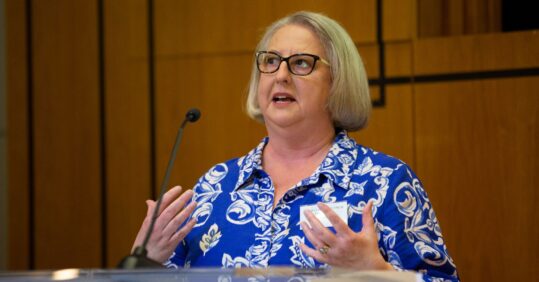Workforce must be seen as ‘the biggest safety critical asset we have’

Workforce planning within health and social care fails to consider risk ‘until something goes wrong’, a professor of workforce modelling has warned.
In a presentation hosted by the Queen’s Nursing Institute (QNI) last week, Professor Alison Leary stressed that the workforce must be recognised as ‘the biggest safety critical asset that we have’ and not as an ‘expensive commodity’.
Professor Leary, who is a QNI fellow and professor of healthcare and workforce modelling at London South Bank University, gave a lecture on Friday as part of a new QNI award presentation, which recognised nurse leadership within community nursing.
Her talk focused on ‘thinking differently about nursing workforce challenges’ and the ‘relationship between workforce and safety’.
While she believed than within most safety critical industries the relationship between the workforce and safety was ‘very well established and very well understood’, she said ‘it isn’t so much in health and social care’.
‘I would say good nursing is highly skilled labour. It is complex work and… I think particularly district nursing is one of the most complex workforces that I have ever worked with.
Related Article: NHS 10-year plan: What does it mean for nursing?
‘It is very high-risk work and the consequences of not doing it properly can be catastrophic.’
However, Professor Leary said that nursing work was ‘often invisible’. ‘This is one of the issues that I think we face quite a lot of the time,’ she noted.
She added: ‘One of the things that I have noticed around workforce planning in health and social care is that risk isn’t really considered until something goes wrong.
‘Whereas, fundamentally, in most safety critical industries, we would consider risk at the outset. Certainly, within areas like aviation, and so it’s a very, very different way of doing things.’
Having looked back over several decades of inquiries, including Mid Staffs, it was clear that ‘the number of staff matter’, as well as workloads, leadership and workplace culture.
Professor Leary also noted how she was ‘increasingly approached on social media with people who are concerned about the normalisation of poor care’.
Within healthcare, Professor Leary was concerned about the lack of an ‘overarching safety regulator’. Without this, it ‘means when things go wrong, there is very little change in legislation or regulation to make them right’, she added.
Overarchingly, Professor Leary said that ‘addressing safety would not only make the workforce happier, it would probably also make patients happier, and it would probably also make the system more efficient’.
She went on to highlight how the healthcare workforce ‘is the major agency for delivering work in healthcare’. But added that ‘unlike other safety critical industries’, the healthcare workforce was ‘modelled as if it was a service industry like retail grocery or retail pharmacy or hospitality sector’.
‘We have demand for labour which we don’t really understand,’ she said. ‘We know there are lots of people on waiting lists, but we don’t understand the actual demand for skilled labour. Next to that, we carry very high operational risks.’
Related Article: Funded nurse workforce plan needed for neighbourhood health services
Professor Leary raised concerns about the way in which the healthcare workforce had been modelled to ‘throw out all our newly qualified people onto the frontline’.
‘It’s what we call in safety critical workforce modelling, [the] rookie factor. If you have a very high rookie factor, you increase the risk of things going wrong,’ she added.
‘Because you’re asking those people to make decisions that they’re probably not ready to make yet.
‘And they have to choose what they pass on to a more experienced workforce.’
This could cause ‘discontent and upset’ and ‘helps people want to leave the system’, she said.
Later in her presentation, Professor Leary dove deeper into the reasons that nurses leave their jobs.
She highlighted how retirement continued to be ‘the biggest reason people leave’, but also stressed that less people were now coming back to work during retirement than in previous years.
Related Article: Over one million children living in homes causing asthma and chronic illness
Exhaustion, pay, work-life balance, moral distress and injury, and not having the tools they need to do their jobs were also key reasons nurses left.
Professor Leary said it was her view that a ‘systematic, humanistic approach’ to working in healthcare was needed.
‘At the moment the workforce, I think, is still seen as an expensive commodity, but actually it is the biggest safety critical asset that we have,’ she said.

See how our symptom tool can help you make better sense of patient presentations
Click here to search a symptom




